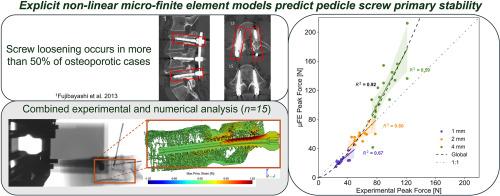Experimental and micro-finite element analysis of the toggling behaviour of a carbon fibre-reinforced PEEK pedicle screw
IF 3.5
2区 医学
Q2 ENGINEERING, BIOMEDICAL
Journal of the Mechanical Behavior of Biomedical Materials
Pub Date : 2025-08-14
DOI:10.1016/j.jmbbm.2025.107167
引用次数: 0
Abstract
Primary stability of pedicle screws is critical for successful spinal fixation, particularly in osteoporotic patients, where screw loosening occurs in over 50 % of cases. This study combined experimental and numerical approaches to evaluate the primary stability of carbon fibre-reinforced polyether-ether-ketone (CF/PEEK) screws under toggling loading conditions.
Fifteen human cadaveric vertebrae with low bone mineral density were tested using a multidirectional loading setup with custom-designed, 3D-printed guides for accurate screw placement. Toggling tests were conducted under displacement-controlled linear loading–unloading ramps with increasing displacements (1, 2, and 4 mm). To complement the experiments, a sample-specific, explicit non-linear micro-finite element (μFE) model was developed to simulate the toggling tests. Experimental and numerical peak forces and tangential stiffnesses were compared at different displacement levels.
Experimentally, no significant correlation was found between mean bone volume fraction in the vicinity of the screw and peak forces. Similarly, volumetric bone mineral density did not show significant correlation with the experimental biomechanical variables. However, μFE-derived peak forces showed significant correlation with experimental measurements at all displacement levels (R2 = 0.67, R2 = 0.60, R2 = 0.59 at 1 mm, 2 mm and 4 mm displacement, respectively), with the model slightly overestimating the experimental values at higher displacements (e.g., 4 mm). Across all data points, μFE and experimental peak forces strongly correlated (R2 = 0.92), following a power-law relationship.
This study demonstrates that non-linear μFE models can reliably predict the primary stability of pedicle screws, offering potential for optimizing screw designs and reducing clinical failure rates associated with loosening.

碳纤维增强PEEK椎弓根螺钉切换特性的实验与微有限元分析
椎弓根螺钉的初始稳定性对于脊柱固定的成功至关重要,特别是在骨质疏松症患者中,超过50%的病例发生螺钉松动。本研究采用实验和数值相结合的方法评估了碳纤维增强聚醚酮(CF/PEEK)螺钉在切换载荷条件下的初级稳定性。15个低骨密度的人尸体椎骨使用多向加载装置进行测试,该装置带有定制设计的3d打印导轨,用于精确放置螺钉。在位移控制的线性加载-卸载坡道上进行切换试验,并增加位移(1、2和4 mm)。为了补充实验,建立了一个针对特定样品的显式非线性微有限元(μFE)模型来模拟切换试验。比较了不同位移水平下的峰值力和切向刚度的实验值和数值值。实验中,螺钉附近的平均骨体积分数与峰值力之间没有明显的相关性。同样,体积骨密度与实验生物力学变量没有显着相关性。然而,μ fe推导的峰值力与实验测量值在所有位移水平(分别为1 mm、2 mm和4 mm时R2 = 0.67、R2 = 0.60和R2 = 0.59)均有显著相关性,且模型在较大位移(如4 mm)时略高估了实验值。在所有数据点上,μFE与实验峰值力呈强相关(R2 = 0.92),服从幂律关系。该研究表明,非线性μFE模型可以可靠地预测椎弓根螺钉的初级稳定性,为优化螺钉设计和减少与松动相关的临床失败率提供了可能。
本文章由计算机程序翻译,如有差异,请以英文原文为准。
求助全文
约1分钟内获得全文
求助全文
来源期刊

Journal of the Mechanical Behavior of Biomedical Materials
工程技术-材料科学:生物材料
CiteScore
7.20
自引率
7.70%
发文量
505
审稿时长
46 days
期刊介绍:
The Journal of the Mechanical Behavior of Biomedical Materials is concerned with the mechanical deformation, damage and failure under applied forces, of biological material (at the tissue, cellular and molecular levels) and of biomaterials, i.e. those materials which are designed to mimic or replace biological materials.
The primary focus of the journal is the synthesis of materials science, biology, and medical and dental science. Reports of fundamental scientific investigations are welcome, as are articles concerned with the practical application of materials in medical devices. Both experimental and theoretical work is of interest; theoretical papers will normally include comparison of predictions with experimental data, though we recognize that this may not always be appropriate. The journal also publishes technical notes concerned with emerging experimental or theoretical techniques, letters to the editor and, by invitation, review articles and papers describing existing techniques for the benefit of an interdisciplinary readership.
 求助内容:
求助内容: 应助结果提醒方式:
应助结果提醒方式:


